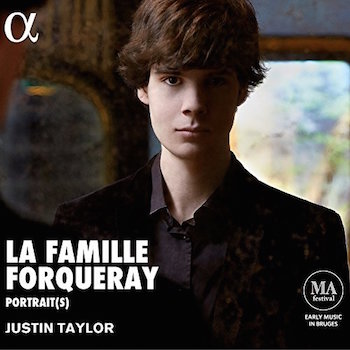Classical CD Reviews: Shai Wosner’s Haydn/Ligeti and Justin Taylor’s “La famille Forqueray”
Hats off to harpsichordist Justin Taylor for the resonant, gripping performances he turns in on his debut album; pianist Shai Wosner showcases Haydn and Ligeti, side-by-side.

By Jonathan Blumhofer
What do Franz Josef Haydn and György Ligeti have in common? More than a little, it turns out. Both were masters of whimsy and depth – and each developed distinctive ways of conveying their personalities through their music. Thanks to pianist Shai Wosner, the Danish National Symphony Orchestra (DNSO), and Nicholas Collon, we’ve now got an album (Onyx Records) showcasing the two of them, via their piano concertos and capriccios, side-by-side.
I’m of two minds, though, when it comes to Wosner’s take on Ligeti’s Piano Concerto. On the one hand, his interpretation has notable strengths: he owns the notes, his playing is brilliantly involved, and his approach to the score, movement-to-movement, is consistent. But it’s not very aggressive and doesn’t seem to take full measure of the music’s expressive depths. It is, by just a notch or two, laid-back Ligeti, and that lack of belligerent, manic urgency – which you get in both of Aimard’s recordings of the piece (on Deutsche Grammophon and Teldec, respectively) – ultimately robs this reading of some necessary immediacy.
So, too, the orchestral accompaniment. The occasional wailing horn solos (to take but one example) aren’t particularly raucous and, for all the lush clarity of the playing, parts of it (like the screaming writing for high winds in the second movement) might have benefited from a more hostile mood.
Still, there’s nothing paltry about the technique behind the DNSO’s playing and, sometimes, a softer makeover enhances the Concerto’s weirdness (like when the rest of the orchestra joins in after that bawling woodwind section in movement two). Even so, and taking into account the sumptuous roundness of the orchestral sound (surely the piece has rarely sounded so clean or smooth on disc before), this is a reading that, overall, struck me as a bit too hygienic.
In the Haydn concertos, on the other hand, there’s no question that Wosner and the DNSO have a special understanding of the music’s off-beat charm. The D-major Concerto kicks: the outer movements dance with dry crispness and the slow middle one sings with winning immediacy. So does the G-major Concerto that opens the disc. In both readings, the finale’s trip with a mixture of Classical grace and spirited humor. It’s all wonderfully invigorating and spiritually rejuvenating.
So are Wosner’s performances of a pair of Capriccios by both composers. The pair by Ligeti date from 1947 and pretty strongly reflect the influence of Bartók. Wosner prods them along with heavily-rhythmic interpretations that suit the music admirably. He follows each up with excellent, fluid performances of, respectively, the G- and C-major Capriccios of Haydn. The contrasts of character and mood between these 18th-century chestnuts echo the later works intriguingly; here, Wosner’s a perfectly stylish, convincing curator.

If any instrument is particularly hard to make sound not just good but truly musical, engaging, and exciting, it’s probably the harpsichord. So hats off to Justin Taylor for the resonant, gripping performances he turns in on his debut album, La famille Forqueray (from Alpha-Classics). (In the interest of full disclosure, I should point out that Taylor’s father, John, is regular contributor to the Arts Fuse.) A survey of pieces by Antoine and Jean-Baptiste Forqueray (father and son), filled out by a couple of compositions by Francois Couperin and Jacques Duphly, it features as handsomely-played and downright enjoyable a harpsichord recital as I’ve heard.
Both of Jean-Baptiste’s suites recorded here (nos. 1 and 5) are personable reworkings of the genre, adapting the familiar Baroque dances into portraits of various contemporaries – and, in one case, a deity. They’re also pieces that exhibit strong rhythmic sensibilities as well as a kind of sweeping melodic style: “La Bellemont,” the First Suite’s fourth movement, surges with driving momentum while “Jupiter,” the Fifth Suite’s finale, alternates short, pensive breaks in its otherwise florid writing, building in energy and virtuosity to a stirring conclusion. And, in slower movements, like “La Montigni” and “La Cottin,” those qualities carry over into writing of notable lyricism.
The two selections on this disc from Antoine’s pen – the Prelude non Mesure in D minor and Pieces pour 3 Viols – are, in contrast, a bit less distinctive in character. That’s not to say they’re uninteresting. The “Courante” from Pieces explores some interesting harmonic terrain and the Prelude sets up Jean-Baptiste’s first harpsichord suite smartly.
As for the Couperin and Duphly works (both rather generically titled Pieces de clavecin), they offer fine, melodious examples of the high French Baroque style. The Duphly, in particular, is a welcome discovery, its runs of sequences and pungent harmonic progressions managing to both charm the ear and keep the mind guessing where it will head next.
Throughout the album, Taylor’s playing is muscular and technically superb. He clearly loves this music and has something to say about it: the same sort of infectiousness that marks Wosner’s Haydn is plainly evident here, too.
Jonathan Blumhofer is a composer and violist who has been active in the greater Boston area since 2004. His music has received numerous awards and been performed by various ensembles, including the American Composers Orchestra, Kiev Philharmonic, Camerata Chicago, Xanthos Ensemble, and Juventas New Music Group. Since receiving his doctorate from Boston University in 2010, Jon has taught at Clark University, Worcester Polytechnic Institute, and online for the University of Phoenix, in addition to writing music criticism for the Worcester Telegram & Gazette.
Tagged: Alpha-Classics, harpsichord, Justin Taylor, La famille Forqueray, Nicholas Collon, Onyx Records, Shai Wosner
